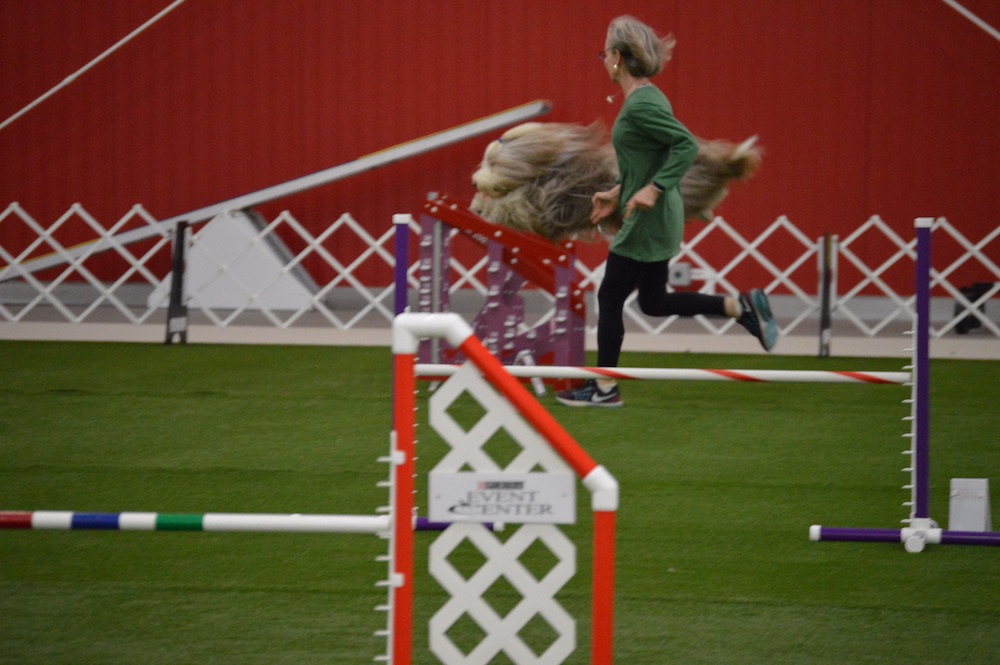
Last week I attended the Bearded Collie Club of America National with my two highly energetic and driven dogs, along with about two hundred other competitors. A calm vacation it was not. My dog athletes enjoyed multiple days of performance competition, capped off by show competition.
For people who believe dogs are pets and don’t have emotional lives, let me introduce you to my beardies. They have goals. It’s my job to help them achieve those goals. To do that I need to understand how to get performance, and to improve it.
I have learned a lot about meeting goals of others from raising dogs as well as children. With my own goals, I now have the flexibility to determine my time-frame and criteria for achievement. When performance is judged for my dogs, that flexibility disappears. We are judged only on the outcome, and we get scores that are compared with others. Prizes are awarded, or not.
Excellent Performance is Propelled by Both Data and Engagement
I don’t want to imply that training dogs for performance is anything like tackling the complexity of health care performance. But sometimes it’s instructive to step back and look freshly on performance from a different perspective. Why? Because in both cases, although there is a quasi-scientific process to master performance, there is something else propelling the achievement of results—the art of making it happen.
In both venues, there is a common performance framework: a science of measurement, performance measures, the challenge of meeting performance amidst distractions, and interventions for improvement.
There is also data. Data in dog performance? Absolutely. When a dog is experienced in jumping, he knows the exact distance from a jump obstacle for takeoff and landing that will scale the height of the jump. He also knows, by “reading” the line of the agility course, that if the next jump is at an angle to the first and not straight ahead, he must make the first jump by collecting and not extending his body. In other words, he will jump short instead of long. These are measurements he must learn through practice, data that he imprints on his memory.
But data is only one piece of the puzzle. In dog performance, both participants, human and dog, are fully engaged, which affects our results. My impact on my dog’s results is as important as my dog’s ability to run the agility course. I can be the deciding factor in success or failure. Nervousness or overexcitement on either part can fail us. We are a team.
Instilling Performance Requires Involvement
There is a baffling yet common process in health care organizations to issue quality measure or cost results to physicians as scores, and then expect them to fix performance. Instead, they rebel. The data is wrong, the patients are sicker, the patients weren’t compliant, the system was problematic—any number of reasons are categorized by executives as excuses, even if true. The real problem is that the physician wasn’t engaged in the first place, had no input into the process nor agreement with the criteria.
If I am running my dog in agility or performing in obedience trials, I know better than to work with a dog that doesn’t care if she is there. I spend a lot of time coaching her along the way. If she doesn’t trust the teeter-totter, I teach her that it’s not scary. I make games that reward fast weave-pole performance, and I whoop it up at the end of a good run. Most of all, I have to teach that it is fun, and that we are doing this together. If there is no partnership, there is no team, and we can’t possibly succeed. Yes, agility is a game (for us); for the dogs, it is their work.
A few weeks ago, I was involved in a performance improvement project with a health care client. It was novel and was focused on improving outcomes for difficult patients. I was so struck by the excitement of the physicians, by creative thinking about managing aspects of the project, and by input into the criteria and the process. Physicians want contribution. If they are passive in the process, we cannot meet the goals.
Performance Can Only Improve Over Time—And Slowly
I spent six weeks this summer trying to eliminate foot movement in a dog’s Sit. Prancing feet (which bearded collies do by nature) indicate that the dog will break the Sit and move off. If I want to get to a good performance on the ensuing command, a Stay, I must break performance into steps. First I must get the dog to understand that he is moving his feet, which is very difficult because it is emotional—he is expressing his excitement. Then I must be able to look away or move around the dog without foot movement, and then add distractions, like toys.
Each part of performance is a separate step, and the process is iterative. It takes patience, calmness and, yet, a fun attitude to keep my dog engaged. I work alternative positions to get better results; I add new elements of a game. And because it is enjoyable and not a huge amount of work, we succeed. That’s how I got my first Rally Obedience Stay at the National and the first leg of our next title.
Performance Improvement Can’t Be Blame and Shame
When I think about how performance improvement is undertaken in health care, I am struck by how often organizations can be quick to point blame at physicians based on limited data and poor measures. In many organizations, administrators provide only aggregate reports to physicians, permitting no feedback on individual patient results or establishing a foundation for real improvement. If a process of improvement is organized, it may include physician executives but not always rank-and-file practices.
When compensation is linked to the achievement of measures, do physicians take away any value from performance measures? Are they more or less inclined to become involved in long-term improvement of their patients? What support do they get for improving individual patient results, if only aggregate scores matter?
Improvement in outcomes is driven by emotion in addition to facts. Both the physician’s leadership and compassion and the patient’s confidence and emotional status will play a part in getting good results. Achieving success is a process that cultivates the creation of a scientifically-based clinical plan yet also nurtures physician leadership and patient confidence, while supporting the emotions of those participants.
Performance improvement is not solely scientific; it slowly unfolds under circumstances that allow it to succeed. It is an iterative, step-by-step, creative process that involves far more than data, one that depends on a true connection between all parties who actively and enthusiastically own the process. That is the art of making it happen.
Founded as ICLOPS in 2002, Roji Health Intelligence guides health care systems, providers and patients on the path to better health through Solutions that help providers improve their value and succeed in Risk. Roji Health Intelligence is a CMS Qualified Clinical Data Registry.
Image Credit: Jim Cayo






